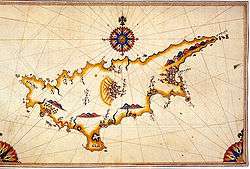Chypre
Chypre (pronounced [ʃipʁ] or [ʃipχ]) is the name of a family (or concept) of perfumes that are characterised by an accord composed of citrus topnotes, a middle centered on cistus labdanum, and a mossy-animalic set of basenotes derived from oakmoss. Chypre perfumes fall into numerous classes according to their modifier notes, which include but are not limited to leather, florals, fruits, and amber.[1]
History
The term chypre is French for the island of Cyprus. Its connection to perfumery originated with the first composition to feature the bergamot-labdanum-oakmoss accord, François Coty's 1917 perfume Chypre (now preserved at the Osmothèque), whose name was inspired by the fact that its raw materials came predominantly from Mediterranean countries.[2] Although perfumes in a similar style had already been created in the 19th century, Chypre was so influential that it inspired many descendants, becoming the progenitor of a whole family of related fragrances sharing the same basic accord, which came to be known as chypres.[3] The chypre concept is characterised by the contrast between the fresh citrus accord and the woody-oakmoss base; often patchouli is considered an indispensable element as well.[4] The chypre accord is used in both male and female perfumery.
In popular culture
A notable literary reference to chypre is contained in the novel The Maltese Falcon by Dashiell Hammett (Knopf, 1929), in which the character Joel Cairo is described as carrying a chypre-scented handkerchief as part of his homosexual persona. Raymond Chandler's The Lady in the Lake (Knopf, 1943) also mentions a chypre-scented, monogrammed handkerchief. Brave New World written by Aldous Huxley in 1932, the main female character, Lenina Crowne, “dabbled herself with chypre” after drying off from a bath.
Notable examples
One of the most popular chypre perfumes was the original Miss Dior, a floral chypre launched by Christian Dior in 1947. The formula was later changed, likely due to issues with the ingredient oakmoss. Since the mid-1980s, Karl Lagerfeld cologne, orange in color, called "Lagerfeld" is a modern chypre scent for both men and women.
In the 1950s and 60s in the USSR, "ШИПР" Shipr, became a popular men's fragrance. Today ШИПР is still available in Russian cosmetic stores and it is a popular scent among women.
Style
Modern chypre perfumes have various connotations such as floral, fruity, green, woody-aromatic, leathery, and animalic notes, but can easily be recognized by their "warm" and "mossy-woody" base which contrasts the fresh citrus top, and a certain bitterness in the dry-down from the oak moss and patchouli. The accord consists of:
- Citrus: singular or blends of Bergamot, Orange, Lemon or Neroli
- Oakmoss: mossy and woody
- Patchouli: camphoraceous and woody
- Musk: sweet, powdery, and animalic. Usually synthetic in modern times.
The composition is usually enhanced with a floral component through rose and jasmine oil.
Animalic notes such as civet can be added to this accord to provide richness, but are less popular in modern perfumery. The most common modifiers to this basic accord include patchouli, bergamot, vetiver, ambergris, sandalwood and labdanum resin.[5]
Sub-families of chypre
The chypre fragrances generally fit into the Oriental and Woody family of fragrance wheel classification. They can also be classified into several styles:
- Leather and/or animalic chypres, such as Bandit by Robert Piguet (1944), Cabochard by Grès (1959), and Azurée (1969) by Estée Lauder.
- Floral chypres, such as Knowing by Estée Lauder, 1988.
- Fruity chypres, such as Femme by Rochas, 1944, Mitsouko by Guerlain, 1917, and Y by Yves Saint Laurent, 1964.
- Green chypres, such as Givenchy III by Givenchy (1970), Aliage by Estée Lauder, 1972 and Cuvée Spéciale by Charvet.[6]
- Woody-aromatic chypres, such as Aromatics Elixir by Clinique, 1972.
- Fresh-citric chypres, such as CK One by Calvin Klein, 1994.
References
- ↑ "Chypre" Microsoft Encarta Dictionary, 2006
- ↑ Turin, Luca, and Tania Sanchez. The Little Book of Perfumes: The 100 Classics. London: Profile, 2011. Print.
- ↑ Musées de Grasse Archived 2007-08-10 at the Wayback Machine., the International Perfume Museum
- ↑ H&R Fragrance Guide/Duftatlas/Atlas Olfactif, Quensen & Oudras Verlag, Lamspringe, 2000, p. 14, ISBN 3-922805-69-8
- ↑ Definition of the chypre family from Musées de Grasse
- ↑ "Charvet Cuvee Speciale". basenotes. Retrieved December 14, 2010.
